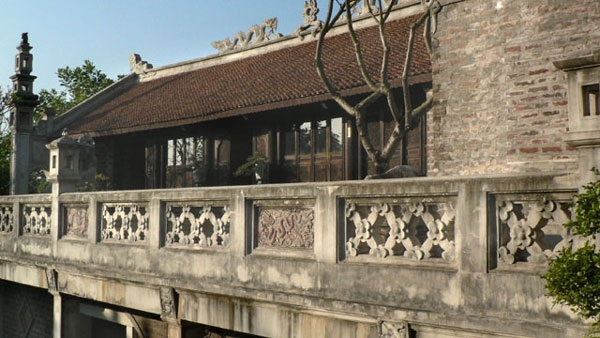
|
|
A corner of Thanh Chuong's Viet Palace -- Photo: NDO
|
The painter said that heritages are naturally opulent, therefore preservation of this opulence is a way to sustainably conserve treasures that ancestors have left.
The inevitable result of the love
A period of 15 years is not very long, but long enough for Viet Palace to have left an impression on many people. Do you remember the beginnings of the palace?
I still remember when this place was a bare hill of gravel and rocks. Over the past 15 years, we have devoted our hearts and minds to building and preserving the palace, contributing to inspire the love and responsibility of preserving invaluable cultural heritages for the community. This road has been miserably difficult but sweet.
Born in a northern village, my family’s traditions, particularly my father's, inspire an enduring love for traditional culture in me. Viet Palace was the inevitable result of this love. With my accumulated knowledge of Vietnamese culture, I decided to build Viet Palace in order to share aspects of traditional culture from our ancestors, conveying a message of preserving and promoting each of their values.
The 8,000 square metre hill has become a space for my ideas. Being a visual artist, I was very strict in arranging and decorating the space.
I did not stereotypically arrange the models and collections of artifacts. I brought artifacts back to real life in the past, but in harmony with the elements of the new era.
Viet Palace is not only considered a space for keeping a huge amount of artifacts and cultural heritages, but also as a creative model bearing the hallmarks of Thanh Chuong as a painter. What do you think about this?
Viet Palace is a museum but it was formed according to a new concept. The ancient architectures were not an original copy and the artifacts were not soulless. This makes the complex different from others.
I did not intend to make Viet Palace a museum because it was considered an artistic space.
Quite frankly, it was very difficult for us to give an exact name for the palace. But I wanted to call it Thanh Chuong’s Viet Palace Cultural Space.
Where to find precious values
More than 2,000 unique artifacts and 15 specific architectural features are displayed at Viet Palace, while elsewhere many valuable artifacts are being lost. Is this the reason why the palace has attracted public curiosity since being built?
Right from the start, I did not intend to make Viet Palace a tourism destination. The project was initiated in 2001 and attracted the first visitors in 2002. The public has not witnessed any valuable and successful cultural projects imbued with national identities for a long time. In particular, it is an individual project, not invested and built by the State.
The project’s appearance blew a fresh breeze into an atmosphere lacking the vitality of the country’s cultural life. Over the past years, Viet Palace has welcomed numerous domestic and foreign visitors. Many people have a strong desire to revisit the origins of national culture and the palace satisfies their desire.
I could not have imaged that people would be interested in and love the palace so much. Writer Nguyen Quang Thieu said that at Viet Palace, visitors can find intimate images including village ponds and wells, as well as houses with red roofs.
Former Hanoi Party Secretary Pham Quang Nghi affirmed that Viet Palace was a symbol of not only painter Thanh Chuong, but also the capital and the country. Former American Ambassador to Vietnam Raymond Burghard also said that with this project, Thanh Chuong had made the dream a reality. How do you take this?
Encouragements like this have been a great inspiration for us. Viet Palace has had numerous names such as ‘The shelter of Vietnamese soul’, ‘Where dead Vietnamese beauties are revived’ and ‘Peaceful kingdom of Vietnamese cultural heritages’. Swedish Queen Silvia and the Royal delegation visited Viet Palace in 2004 when it was not quite perfect.
According to the Swedish Embassy in Vietnam, Viet Palace was a Vietnamese culture complex as well as a creative and valuable living museum for Vietnamese culture. Since 2004, more and more foreign ambassadors have visited the palace and all of them were deeply impressed by the space.
Are you satisfied with this project that you have devoted your heart and mind to create?
I do not exactly remember how much money I spent to build Viet Palace. I had to move heaven and earth myself to earn money to pay for the workers as well as preparing and building the project’s items. I cared for the palace during the day and painted pictures and illustrations at night.
The increase in the number of visitors to the palace to enjoy a Vietnamese cultural space with artifacts, ancient houses and wells, houses on stilts and stone bridges is our gift. I believe that Viet Palace will develop more in the future.
Thank you very much!
| related news |
|
Thanh Chuong Viet Palace in Black & White |
Nhan Dan